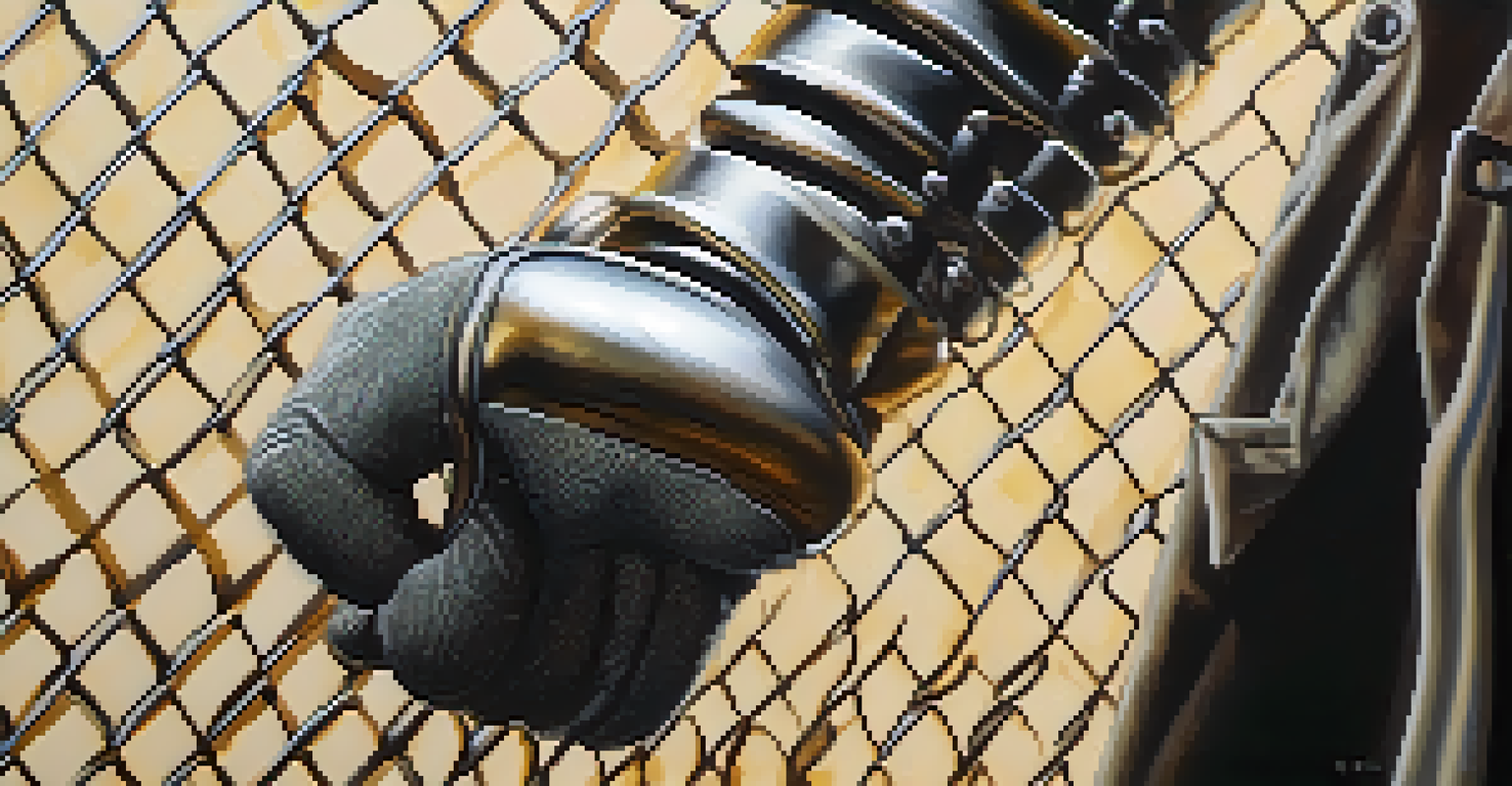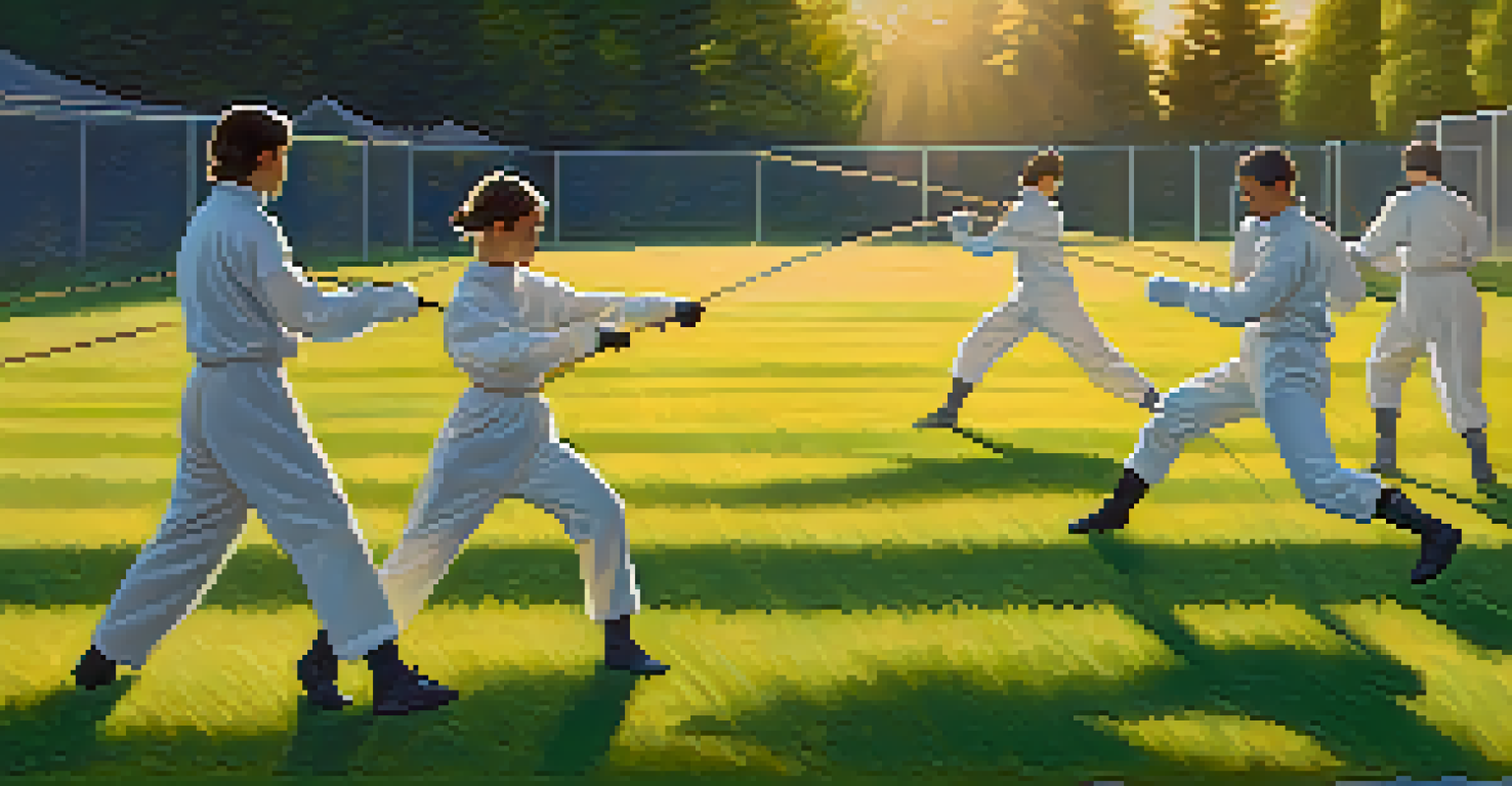Advanced Fencing Strategies: Outthinking Your Competition

Understanding the Basics of Fencing Strategies
Before diving into advanced tactics, it's essential to grasp the fundamentals of fencing. Knowing the basic stances, footwork, and blade control is crucial because these elements form the foundation for more complex strategies. Just like a musician must master scales before composing, a fencer needs to be proficient in the basics to build upon them effectively.
The best way to predict the future is to create it.
Once you're comfortable with the basics, you can start to think strategically about your approach. This means analyzing your opponent’s strengths and weaknesses, as well as your own. By developing a keen sense of awareness, you can better predict what your opponent might do next, allowing you to counter their moves more effectively.
Ultimately, mastering the basics sets the stage for advanced strategies, where the real mental game begins. As you move forward, remember that even the most complex tactics are rooted in fundamental skills. The transition from basic to advanced is not just about adding new techniques, but also about refining your existing abilities.
Analyzing Your Opponent: The Key to Outthinking Them
One of the most effective advanced strategies in fencing is to analyze your opponent's style and tactics. Every fencer has a unique approach, whether it’s aggressive, defensive, or a mix of both. By observing their movements and habits during a bout, you can gather vital information that will help you anticipate their next actions.

Consider keeping a mental or even a physical note of your opponent's strengths and weaknesses. For instance, if you notice they tend to overextend on their attacks, you can exploit this by timing your counterattacks perfectly. This kind of analysis is akin to a chess player studying their opponent’s previous games to predict their moves.
Mastering Basics is Essential
A strong foundation in basic stances, footwork, and blade control is crucial for developing advanced fencing strategies.
Ultimately, the ability to read your opponent effectively can be the difference between victory and defeat. By staying one step ahead, you not only enhance your chances of winning but also instill a sense of uncertainty in your opponent. This psychological edge can often lead to mistakes on their part, giving you the upper hand.
The Importance of Timing in Advanced Fencing
Timing can make or break your performance in fencing. It’s not just about executing moves; it’s about knowing when to strike and when to hold back. Think of it like a dance: every step must feel natural and well-timed to create a seamless flow. In fencing, a perfectly timed attack can catch your opponent off guard and lead to a decisive point.
In the midst of movement and chaos, keep stillness inside of you.
To develop your timing, practice drills that focus on rhythm and reaction. For example, engage in exercises that require you to attack as soon as your opponent commits to a movement. This way, you train your body to respond instinctively, ensuring that your timing becomes second nature during actual bouts.
Good timing is often the result of experience and observation. As you gain more experience on the strip, you’ll begin to sense the rhythm of bouts, allowing you to adapt your timing accordingly. This adaptability can be a powerful tool in your advanced fencing arsenal, enabling you to outthink and outmaneuver your competition.
Employing Feints and Deceptions in Your Strategy
Feints and deceptions are essential tools in the advanced fencer's toolkit. By pretending to execute one move while secretly preparing for another, you can throw off your opponent’s expectations. It’s like throwing a curveball in baseball; the goal is to catch them off guard and create an opening for an effective attack.
To master feints, practice combining them with your footwork and distance management. For instance, you might feint an attack to the torso while simultaneously moving in to target the head. This requires precision and good control, but when done correctly, it can lead to significant advantages in the bout.
Analysis Leads to Advantage
Carefully observing and analyzing your opponent's style can provide valuable insights that help you anticipate their moves.
Remember, the key to successful feints is not just the action itself, but also your ability to sell the move. Your body language, facial expressions, and even your breathing can all contribute to making your feint more convincing. When your opponent believes in your deception, they are more likely to fall for it, giving you the perfect opportunity to strike.
Using Footwork to Create Opportunities and Openings
Footwork is often underestimated but plays a vital role in advanced fencing strategies. Well-executed footwork allows you to control the distance between you and your opponent, which can create openings for attacks or help you evade incoming strikes. Imagine a boxer dancing around the ring, always staying just out of reach while looking for an opportunity to counter.
To enhance your footwork, incorporate agility drills into your training routine. These drills can help you develop quick lateral movements, enabling you to shift your position strategically during a bout. The more agile you are, the more options you’ll have to create openings for your attacks or to retreat when necessary.
Ultimately, effective footwork can transform the way you approach a match. By constantly moving and adjusting your position, you can maintain a dynamic presence that keeps your opponent guessing. This unpredictability is crucial in outthinking your competition, as it can lead them to make hasty decisions that you can exploit.
Mental Preparation: Building Focus and Resilience
Mental preparation is just as important as physical training in fencing. The psychological aspect of the sport can often be the deciding factor in a close match. By cultivating focus, resilience, and a positive mindset, you equip yourself to handle the pressures of competition and outthink your opponents.
To build mental strength, consider techniques such as visualization and mindfulness. Visualizing successful scenarios can boost your confidence and help you prepare for various situations during a bout. Similarly, practicing mindfulness can improve your focus, allowing you to stay present and make better decisions at critical moments.
Adaptability Enhances Performance
The ability to adjust your tactics based on different opponents and styles is key to becoming a versatile and successful fencer.
In addition, developing resilience is crucial for bouncing back from setbacks during a match. Recognizing that mistakes happen and learning from them will help you remain calm and collected. This mental fortitude can give you an edge over opponents who may succumb to pressure, ultimately enhancing your performance.
Adapting to Different Opponents and Styles
One of the hallmarks of an advanced fencer is the ability to adapt to different opponents and their unique styles. Just as a chameleon changes color to blend in, a skilled fencer must adjust their tactics based on who they’re facing. Recognizing when to be aggressive or defensive can be key to outsmarting your competition.
To improve your adaptability, expose yourself to various fencing styles during practice. Spar with different partners and participate in tournaments with diverse opponents. This experience will help you understand how to counter different techniques and styles, making you a more versatile fencer.

Ultimately, the ability to switch gears and modify your approach is what sets advanced fencers apart. As you encounter new challenges, embrace them as opportunities to grow. By remaining flexible and open-minded, you can navigate the complexities of any match with confidence.
Putting It All Together: Crafting Your Unique Strategy
Now that you’ve explored various advanced fencing strategies, it’s time to put everything together and craft your unique approach. This involves integrating elements like timing, feints, footwork, and mental preparation into a cohesive strategy that plays to your strengths. Think of it as a recipe where each ingredient must complement the others to create a delicious dish.
Start by identifying your own strengths and weaknesses as a fencer. Are you more comfortable on the attack, or do you excel at defense? Use this self-awareness to guide your strategy, ensuring that it aligns with your natural tendencies while also addressing areas for improvement.
Finally, remember that crafting your unique strategy is an ongoing process. As you gain more experience and face different opponents, your approach may evolve. Embrace this journey of growth, and soon you’ll find yourself outthinking even the toughest competition with confidence and finesse.